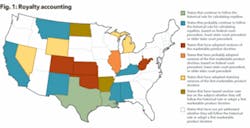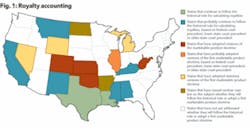A New Era in Oil and Gas Royalty Accounting
Byron C. Keeling
Keeling & Downes PC
Houston
With crude oil trading in the $60 range and with natural gas at a new price deck, oil and gas producers have an incentive to market and trade their production downstream of the wellhead. As a result, the economic, financial, and legal environment for oil and gas trading has entered a new era. This is particularly true in the area of royalty accounting, where lessors and other royalty owners have begun to wage legal battles against producers in an effort to change the historical methods for calculating oil and gas royalties.
Oil and gas leases in the United States commonly tie royalty calculations to a flexible yardstick-for example, “the lessee will pay the lessor a royalty of 1/8th of the market value of the production at the well.” The flexibility of the yardstick creates tension between lessors and lessees. Oil and gas is potentially more valuable at a commercial trading location than at the wellhead. Therefore, lessors and other royalty owners complain that their royalties should be based on the value or price of the production at a downstream commercial market, not at the wellhead.
The Evolving Law of Royalty Accounting
Until recently, courts in most states held that the term “at the well” in a typical lease requires a lessee to calculate its royalty payments on the basis of the value or price of its production at the wellhead. Under this rule, a lessee may determine the wellhead value or price of its production by using a “workback” or “netback” method of royalty accounting in which it subtracts post-production costs (such as transportation, gathering, processing, treating, and marketing expenses) from the downstream sales price of its production. Texas and Louisiana continue to follow this historical rule. Other states that probably also continue to follow the historical rule include Alabama, California, Kentucky, Mississippi, Montana, and New Mexico.
Kansas was the first state to abandon this historical rule. In a series of opinions, the Kansas Supreme Court crafted the “first marketable product doctrine,” holding that a lessee must solely bear all of the post-production costs, other than transportation costs, necessary to produce a first marketable product. The court explained that a lessee may not pay royalties on the basis of a workback value at the wellhead unless its production is “marketable at the well.” According to the Kansas court, “marketability” does not necessarily require the actual existence of a commercial market at the wellhead; however, it does require the production be in a condition where the lessee could sell the production if a market were to exist at the wellhead. The Kansas court placed the burden of proving the point of “marketability” on the plaintiff royalty owner.
Other states have followed Kansas’s lead. Unfortunately, the first marketable product doctrine does not necessarily mean the same thing from state to state.
Oklahoma’s version of the first marketable product doctrine is similar to, but not quite identical to, Kansas’s version. Like the Kansas Supreme Court, the Oklahoma Supreme Court has ruled that a lessee must itself bear all of the costs (other than transportation costs) necessary to derive a marketable product from otherwise unmarketable oil or gas production. Unlike the Kansas court, however, the Oklahoma court has placed the burden of proof on the lessee. Specifically, the Oklahoma court has held that a lessee may use a workback method to calculate royalty payments at the wellhead only if the lessee can prove (i) that its post-production costs enhanced the value of an already marketable product, (ii) that its post-production costs were reasonable, and (iii) that its actual revenues (i.e., its downstream sales price) increased in proportion with the post-production costs that it wishes to subtract from its revenues to calculate the wellhead value of its production.
By comparison with Kansas and Oklahoma, Colorado has adopted a much more extreme version of the first marketable product doctrine. The Colorado Supreme Court has concluded that a lessee must bear all of the costs, including transportation costs, necessary to acquire a first marketable product. According to the Colorado court, “marketability” requires not only that the lessee place its production in a marketable condition, but also that the lessee transport its production to an actual commercial market. Thus, the first marketable product doctrine in Colorado demands that a lessee pay royalties on the basis of the enhanced value of its production at a downstream market, without deducting any of the transportation or other post-production costs that may have enhanced the value of the production.
West Virginia has similarly adopted an extreme version of the first marketable product doctrine. Like the Colorado Supreme Court, the West Virginia Supreme Court has concluded that a lessee must bear all of the transportation costs necessary to deliver its production to a commercial market. In fact, going beyond the Kansas and Oklahoma rule requiring that the lessee bear all costs up to the point where it first acquires a marketable product, the West Virginia court has emphasized that a lessee may not use a workback method to deduct any post-production costs it incurs up to the “point of sale.”
Several other states-notably Wyoming, Michigan, and Nevada-have adopted statutory versions of the first marketable product doctrine.
The law in some oil and gas producing states is unclear. Arkansas appears to be leaning in the direction of adopting a first marketable product doctrine, but its courts have not yet squarely faced the issue. Courts in North Dakota have issued conflicting opinions-a federal court decision favors the historical rule, while a state court decision appears to favor the first marketable product doctrine. Florida, Arizona, Utah, and South Dakota have not yet addressed the issue.
Entering the New Era
Many oil and gas producers continue to follow customs and practices that date back to the days when all states followed the historical rule. Those days, however, are gone. The first marketable product doctrine represents a substantial deviation from the historical rule allowing lessees to use a workback method to calculate the value of their production at the wellhead.
Producers must recognize that the economic, financial, and legal environment has entered a new era. Consequently, producers that own leases in several states should no longer assume that they can use the same formula to calculate their royalty payments for each of their lessees. They may have to radically change their royalty accounting methods for their production in first marketable product states-and, in fact, they may have to use different accounting methods even between those states that have adopted the first marketable product doctrine.
To the extent that a producer is still using a workback method of royalty calculation in a first marketable product state, the producer should consider changing its method of calculating royalties on any oil or gas production that it sells downstream of the wellhead:
• For leases in Colorado or West Virginia, a producer probably should begin calculating its royalty payments on the basis of the price that it actually receives for its production at the downstream market, without taking any deductions from the royalty payments for treating, processing, gathering, compression, marketing, transportation, or other post-production costs.
• For leases in Kansas or Oklahoma, a producer may need to conduct a formal study of the relevant markets. If the producer can identify a market for its production in its natural state at or near the wellhead (e.g., third-party purchasers are actually buying comparable quality oil or gas production at the wellhead from other producers in the same field), then the producer-even though it may actually sell its own production at a downstream market-may still be able to continue using a workback method of royalty accounting. But if the producer cannot identify a market for its production in its natural state at or near the wellhead (or, in particular, if the producer must treat or process the production to make it marketable), then the producer probably should begin calculating its royalty payments on the basis of the price that it actually receives for its production at the downstream market, deducting only a proportional royalty share of its transportation costs and taking no other deductions for post-production costs.
• For leases in Arkansas or North Dakota, a producer should recognize that the law is unclear. The producer may need to visit with its counsel and assess its potential risk in maintaining its existing methods of royalty accounting.
By changing its royalty accounting practices, a producer may arguably raise a red flag inviting its royalty owners to complain about past royalty payments. However, a producer that continues to use a workback methodology in a first marketable product state likely runs a much greater economic risk than a producer that changes its accounting methodology. Lawyers in first marketable product states are scouring available records to identify those producers that continue to use a workback method of calculating royalties. They have sued producers not only for breach of contract but also for fraud, alleging that producers are liable for punitive damages for failing to change their accounting practices to conform with legal precedent adopting the first marketable product doctrine.
With an eye toward the future, a producer should consider changing not only its accounting practices, but also its lease forms and division orders. Courts in states like Colorado and West Virginia adopted the first marketable product doctrine because they found that the term “at the well” did not unambiguously express the intent that the producer may calculate its royalty payments on the basis of the value and condition of its production at the wellhead. Thus, in a first marketable product state, the typical Producer’s 88 lease form, with a clause providing for royalties on the basis of “market value at the well” or “amount realized at the well,” will not protect a producer against having to pay royalties on the downstream price of its oil or gas production.
Conclusion
The emergence of the first marketable product doctrine has created a new era in royalty accounting. Producers may no longer assume that they may calculate their royalty payments the same way in each state in which they have production. They must now be aware of the key differences in the royalty accounting rules from state to state, and they must adjust their accounting practices accordingly. OGFJ
The author
Byron C. Keeling [[email protected]] is a shareholder with the Houston law firm of Keeling & Downes PC. He is a trial and appellate lawyer whose practice consists primarily of commercial cases and oil and gas disputes, including royalty litigation.


